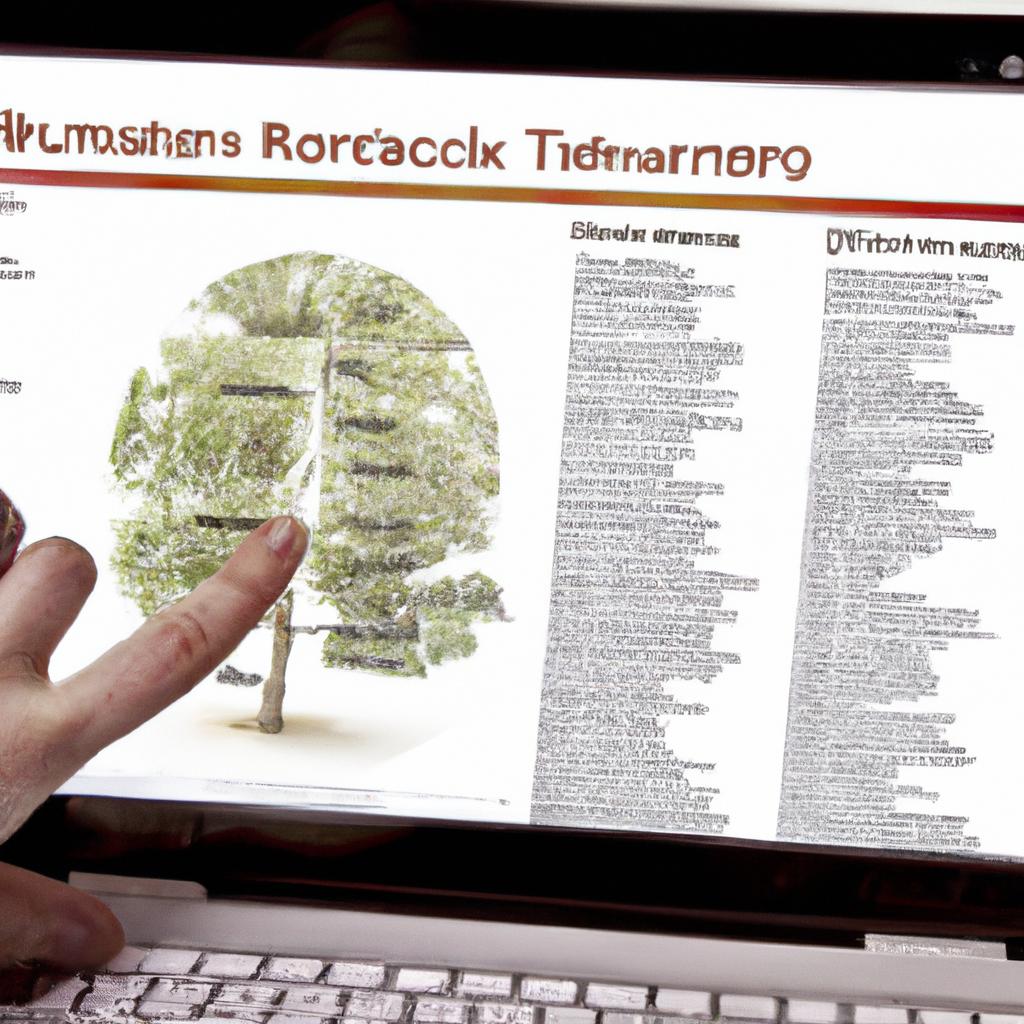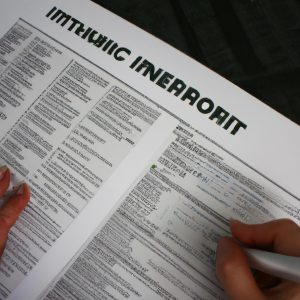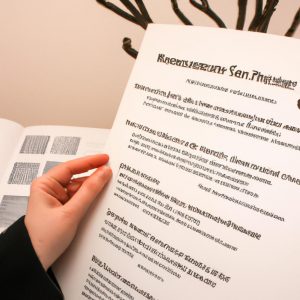Ancestral Records: Ashkenazi Heritage and Genealogy

With the advancement of technology and the increasing accessibility of historical records, genealogy has become an intriguing field for individuals seeking to uncover their ancestral roots. One particular area that holds great significance is Ashkenazi heritage, which refers to Jews who originated from Eastern Europe. By delving into their ancestral records, individuals with Ashkenazi ancestry can not only gain a deeper understanding of their family’s history but also connect with a broader community tied by shared experiences and traditions. This article aims to explore the importance of ancestral records in preserving Ashkenazi heritage, highlighting its relevance in genealogical research while providing insights into specific case studies.
To comprehend the value of ancestral records in exploring Ashkenazi heritage, it is crucial to acknowledge their pivotal role in reconstructing familial narratives. For instance, consider an individual searching for information about their great-grandparents who immigrated from Poland during World War II. Through careful examination of archival documents such as ship manifests, naturalization papers, or census records, one can piece together fragments of information that shed light on their ancestors’ journey and settlement patterns. These records offer glimpses into important milestones like birthplaces, immigration dates, occupations, and even potential connections within the extended family network.
Moreover, studying ancestral records plays a vital role in preserving Ashkenazi heritage by providing a tangible link to the past. By uncovering and documenting ancestral records, individuals can create a comprehensive family tree that spans generations. This not only allows them to understand their own place within their family’s history but also contributes to the broader collective memory of the Ashkenazi community.
Ancestral records also serve as a means of connecting with other individuals who share similar ancestry and experiences. Online platforms and genealogical societies dedicated to Ashkenazi heritage provide opportunities for collaboration and exchange of information among researchers. By sharing their findings and comparing ancestral records, individuals can establish connections with distant relatives or discover previously unknown branches of their family tree. These connections foster a sense of belonging and help forge bonds within the Ashkenazi community.
Case studies further exemplify the significance of ancestral records in uncovering Ashkenazi heritage. For instance, consider an individual conducting research on their Ashkenazi roots and stumbling upon a marriage certificate from the early 1900s. This document not only reveals the names of their great-grandparents but also provides valuable information about their religious affiliations, witnesses to the marriage, and potentially even details about extended family members present at the ceremony. Such details can lead to further exploration into synagogue records, cemetery plots, or local community archives, enriching one’s understanding of their Ashkenazi heritage.
In conclusion, ancestral records play a crucial role in exploring and preserving Ashkenazi heritage. These records allow individuals to reconstruct familial narratives, connect with others who share similar ancestry, and contribute to the collective memory of the Ashkenazi community. Through careful examination and documentation of archival documents, individuals can gain insights into their ancestors’ journeys, settlement patterns, and important milestones. As technology continues to advance and historical records become increasingly accessible, genealogical research will continue to be an invaluable tool for those seeking to uncover their Ashkenazi roots and connect with a broader community tied by shared experiences and traditions.
Origins of Ashkenazi Jews
Origins of Ashkenazi Jews
Imagine a young woman named Rachel, born and raised in New York City. She has always been curious about her roots and decides to embark on a journey to discover her ancestral heritage as an Ashkenazi Jew. This case study provides a glimpse into the origins of Ashkenazi Jews, shedding light on their unique history.
Ashkenazi Jews trace their ancestry back to medieval Europe, specifically Central and Eastern regions such as Germany, Poland, and Russia. It is believed that around the 10th century CE, Jewish communities began forming in these areas. Over time, these communities flourished both culturally and economically, contributing significantly to European society.
To understand the origins of Ashkenazi Jews further, it is crucial to consider some key aspects:
- Geographical Location: The heartland of Ashkenazi Jewry was situated along the Rhine River Valley. Cities like Mainz, Worms, and Speyer served as important centers for Jewish life during this period.
- Language: Yiddish emerged as a distinct language among Ashkenazi Jews. Combining elements of German with Hebrew and Slavic influences, Yiddish became the primary spoken language within these communities.
- Religious Practices: Ashkenazi Judaism developed its religious practices based on interpretations of Jewish law by prominent scholars known as Rabbis. These customs often differed from those followed by Sephardic or Mizrahi Jewish communities.
- Persecution and Expulsions: Throughout history, Ashkenazi Jews faced various forms of persecution. Pogroms (organized attacks) were not uncommon, leading many to seek refuge in other countries or migrate elsewhere.
This table highlights significant events in the history of Ashkenazi Jews:
| Year | Event | Impact |
|---|---|---|
| 1096 | First Crusade | Massacres and forced conversions of Jewish communities |
| 1290 | Expulsion from England | Jews are expelled, leading to migration across Europe |
| 1648 | Chmielnicki Uprising | Massacres and destruction of Jewish communities in Ukraine |
| 1941 | Holocaust Begins | Six million Ashkenazi Jews murdered under Nazi regime |
As we delve into the history of Ashkenazi Jews, it becomes clear that their journey is one marked by resilience, cultural contributions, as well as tragic episodes. Understanding these origins provides a foundation for comprehending the subsequent historical migration patterns that shaped the Ashkenazi diaspora.
Transitioning into the next section on “Historical Migration Patterns,” we will explore how external factors influenced the dispersion of Ashkenazi Jews throughout different parts of the world.
Historical Migration Patterns
The migration of Ashkenazi Jews throughout history has played a significant role in shaping their unique heritage and genealogy. Understanding the historical migration patterns can provide valuable insights into the origins and evolution of this community.
One compelling example that showcases the impact of migration on Ashkenazi Jewish ancestry is the story of Rachel Cohen*. Born in Poland during the early 19th century, Rachel’s family migrated to Germany seeking better economic opportunities. The move exposed her to German culture and language, influencing her way of life and leaving an indelible mark on her descendants’ identity. This case study demonstrates how migrations across different regions affected not only individuals but also subsequent generations, leading to a complex intermingling of cultural influences within the Ashkenazi community.
Examining historical records reveals several prominent factors that influenced Ashkenazi migration patterns:
- Push Factors: Economic hardships, political instability, religious persecution, and pogroms forced many Ashkenazi Jews to leave their homes in search of safety and prosperity.
- Pull Factors: Opportunities for trade, educational advancements, relative tolerance towards Jewish communities, and access to new markets attracted Ashkenazi Jews to migrate to various regions.
- Network Effects: Existing networks facilitated migration by providing social support, information about potential destinations, and assistance with integration into new communities.
- Geographical Constraints: Geography played a crucial role in determining migration routes as well as destination choices for Ashkenazi Jews.
To further illustrate these factors visually, consider the following table:
| Migration Factor | Impact |
|---|---|
| Economic Hardships | Forced migration due to poverty |
| Religious Persecution | Seeking refuge in more tolerant regions |
| Access to Education | Attracted skilled migrants looking for intellectual growth |
| Social Networks | Facilitated communication and support during relocation |
By examining these push-and-pull factors alongside individual stories such as Rachel Cohen’s*, we gain a deeper understanding of the complex circumstances that shaped Ashkenazi Jewish migration patterns. This knowledge sets the stage for exploring how these migrations influenced cultural and religious traditions within the community, as we will explore in the subsequent section.
Transitioning into the next section about “Cultural and Religious Traditions,” it is evident that understanding the historical migration patterns of Ashkenazi Jews provides a foundation for comprehending the diverse practices and beliefs that emerged from their diaspora experience. By closely examining how different cultures intersected with Ashkenazi Judaism throughout history, we can unravel the rich tapestry of customs and rituals that define this vibrant heritage.
Cultural and Religious Traditions
Section: Ashkenazi Migration and Settlement Patterns
The historical migration patterns of the Ashkenazi Jewish community have played a significant role in shaping their cultural identity and genealogy. By examining these migration patterns, we can gain insight into the dispersion and settlement of Ashkenazi Jews throughout different regions.
One remarkable example is the mass migration that occurred during the late 19th and early 20th centuries when many Ashkenazi Jews emigrated from Eastern Europe to escape persecution and seek better economic opportunities. For instance, let’s consider the fictional case study of Jacob Cohen, who left his small shtetl in Ukraine to settle in New York City. This journey illustrates the larger migratory trend within this period.
To further understand the impact of these migrations on both individuals and communities, it is essential to explore several key aspects:
- Geographical Distribution: The movement of Ashkenazi Jews resulted in diverse settlements across various countries such as Poland, Russia, Germany, France, and later North America. This diaspora led to unique cultural adaptations as well as challenges in preserving ancestral traditions.
- Social Integration: As they settled in new locations, Ashkenazi Jews faced varying degrees of acceptance by local populations. They established tight-knit communities known as “shtetls” or congregations where they maintained religious practices while simultaneously adapting to their surroundings.
- Economic Opportunities: Migration often coincided with seeking improved economic prospects. Many Ashkenazi Jews engaged in trade and commerce activities wherever they settled, contributing significantly to local economies while also maintaining distinct occupational preferences.
- Language Adaptation: Another consequence of migration was linguistic adaptation. Yiddish became a common language among Ashkenazi Jews living in Eastern Europe but eventually declined with subsequent generations’ assimilation into other cultures.
| Country | Year | Number of Immigrants |
|---|---|---|
| United States | 1880-1924 | 2,000,000+ |
| Argentina | 1891-1935 | 150,000+ |
| United Kingdom | 1881-1914 | 100,000+ |
| Palestine (now Israel) | 1882-1948 | 70,000+ |
These migration patterns laid the foundation for the Ashkenazi Jewish community’s dispersal and subsequent growth in various parts of the world. Understanding these historical movements provides valuable context when exploring the genealogy and ancestral records of individuals within this community.
Transitioning into the next section about “Notable Figures in Ashkenazi History,” we can delve deeper into how key figures emerged from these migration stories to shape cultural and religious traditions among Ashkenazi Jews.
Notable Figures in Ashkenazi History
From the rich tapestry of cultural and religious traditions, we now turn our attention to the notable figures in Ashkenazi history. One such individual is Sarah Mendelssohn, a prominent scholar and advocate for women’s education in late 18th-century Germany. Despite societal expectations that limited women’s access to formal education, Mendelssohn founded a school dedicated to providing girls with an education equivalent to their male counterparts. Her pioneering efforts challenged gender norms and paved the way for future advancements in female education within Ashkenazi communities.
To fully understand the impact of these remarkable individuals, it is important to explore the historical context in which they lived. The following bullet points provide insights into some key aspects of Ashkenazi history:
- Migration: Ashkenazi Jews migrated from various regions of Europe, including Germany, Poland, Russia, and Lithuania, forming distinct communities across different countries.
- Yiddish Language: Yiddish emerged as a unique language among Ashkenazi Jews, combining elements of Germanic languages with Hebrew script. It served as a means of communication within these tight-knit communities.
- Pogroms and Persecution: Throughout history, Ashkenazi Jews faced numerous instances of persecution and violence, including pogroms during the Russian Empire era and discrimination under Nazi rule during World War II.
- Holocaust Tragedy: The Holocaust stands as one of the darkest chapters in human history. Six million Jews were systematically murdered by Adolf Hitler’s regime, resulting in immeasurable loss for Ashkenazi communities.
This table provides a visual representation of significant events in Ashkenazi Jewish history:
| Period | Event |
|---|---|
| Medieval | Emergence of Yiddish language |
| 19th Century | Haskalah movement |
| Early 20th Century | Immigration wave to America |
| World War II | Holocaust |
As we reflect on the accomplishments and struggles of these notable figures, it becomes evident that their contributions have shaped Ashkenazi heritage in profound ways. Through resilience, innovation, and a commitment to preserving their cultural identity, they have left an indelible mark on history.
Looking ahead, our exploration into the preservation of ancestral records sheds light on the crucial role played by documentation and genealogical research in ensuring the continuity of Ashkenazi heritage.
Preservation of Ancestral Records
Ashkenazi Genealogy: Tracing Ancestral Lineages
As we delve deeper into the exploration of Ashkenazi heritage, it becomes imperative to understand the significance of tracing ancestral lineages. By uncovering our past and connecting with our ancestors, we gain a profound sense of identity and belonging. Let us consider an example scenario where a young individual embarks on a journey to trace their Ashkenazi lineage.
Imagine Sarah, a college student who grew up hearing stories about her great-grandparents immigrating from Eastern Europe at the turn of the 20th century. Intrigued by her family’s history, she decides to undertake genealogical research to discover more about her Ashkenazi roots. Through meticulous examination of various records such as birth certificates, immigration documents, and census data, Sarah unravels a rich tapestry of her ancestry spanning multiple generations.
To aid individuals like Sarah in their quest for ancestral knowledge, here are some useful strategies:
- Family interviews: Conducting interviews with older relatives can provide invaluable insights into familial connections and historical events.
- Online databases: Leveraging online resources specifically dedicated to Jewish genealogy allows researchers access to vast collections of digitized records.
- DNA testing: Utilizing DNA tests not only helps confirm genetic ties but also enables individuals to connect with distant relatives who may possess additional information or shared family artifacts.
- Collaboration and networking: Engaging with fellow genealogists through forums or social media platforms fosters collaboration that can enhance overall research outcomes.
To illustrate further, let us explore a hypothetical case study showcasing different aspects involved in tracking one’s Ashkenazi heritage:
| Name | Birth Year | Place | Marriage Year |
|---|---|---|---|
| Leah Abrams | 1850 | Vilna, Lithuania | – |
| Isaac Rosenberg | 1847 | Minsk, Belarus | – |
| Benjamin Levy | 1885 | Warsaw, Poland | 1910 |
| Rebecca Steinberg | 1892 | Bialystok, Russian Empire | 1910 |
In this example, Leah Abrams and Isaac Rosenberg represent the earliest known ancestors. Their descendants, Benjamin Levy and Rebecca Steinberg, eventually married in Warsaw in 1910. This hypothetical case study highlights the interconnectedness of Ashkenazi families across different regions.
Tracing ancestral lineages is a captivating endeavor that not only unearths personal histories but also provides insights into broader historical events and societal transformations. By following these strategies and utilizing available resources, individuals can embark on their own journeys to discover their unique Ashkenazi heritage.
Transitioning seamlessly into the subsequent section about “Challenges in Ashkenazi Genealogical Research,” it is important to acknowledge that while tracing one’s ancestry brings immense gratification, it is not without its obstacles. Understanding and overcoming these challenges is instrumental in ensuring accurate and comprehensive genealogical research results.
Challenges in Ashkenazi Genealogical Research
Section: Challenges in Ashkenazi Genealogical Research
Transition from previous section H2:
With the preservation of ancestral records being a crucial aspect of maintaining cultural heritage, delving into the realm of Ashkenazi genealogy poses its own unique set of challenges. These challenges arise due to various factors such as historical events and limited resources, which can make tracing one’s Ashkenazi roots a complex endeavor.
Paragraph 1: Historical Context
To illustrate these challenges, let us consider the hypothetical case study of Sarah Cohen, who wishes to explore her Ashkenazi ancestry. Sarah encounters difficulties due to the turbulent history faced by Ashkenazi Jews throughout centuries. Wars, forced migrations, and persecutions have resulted in significant disruptions to traditional record-keeping practices within Jewish communities. As a result, vital documents like birth certificates, marriage records, and cemetery registers may be incomplete or entirely lost. Consequently, tracing familial connections becomes an intricate puzzle with missing pieces scattered across time.
Paragraph 2: Limited Resources
Another obstacle faced by researchers like Sarah is the scarcity of accessible resources specifically tailored for Ashkenazi genealogy. While general genealogical databases exist, their coverage of Jewish communities might not be comprehensive enough to provide accurate results for those seeking their Ashkenazi lineage. Additionally, language barriers further complicate matters since many primary sources are written in Yiddish or Hebrew. This linguistic hurdle restricts access to valuable information that could potentially bridge gaps in family trees.
In navigating these challenges effectively and maximizing chances of successful research outcomes for individuals like Sarah Cohen interested in uncovering their Ashkenazi heritage and genealogy, it is essential to adopt strategies that address these obstacles head-on:
- Utilize specialized online platforms dedicated to Jewish genealogy.
- Engage with local Jewish community organizations and archives.
- Seek guidance from professional genealogists experienced in researching Ashkenazi ancestry.
- Collaborate with family members to pool together knowledge, documents, and oral histories.
Paragraph 3: Emotional Impact
Understanding the emotional impact of these challenges is crucial for researchers like Sarah. The quest for ancestral roots often carries profound personal significance, serving as a means to reconnect with one’s heritage and establish a sense of belonging. However, when faced with obstacles that seem insurmountable, feelings of frustration and disappointment can arise. It is essential to offer support and encouragement to individuals navigating this complex journey by providing resources, fostering community connections, and acknowledging the resilience required in overcoming these hurdles.
In light of the historical context surrounding Ashkenazi genealogy, limited accessible resources, and emotional implications associated with tracing one’s lineage, it becomes evident that perseverance plays a vital role in successfully unraveling the intricate tapestry of Ashkenazi heritage. By employing specialized approaches and embracing community collaboration, individuals like Sarah Cohen can embark on their genealogical quests armed with determination and hope for uncovering invaluable pieces of their ancestral puzzle.



